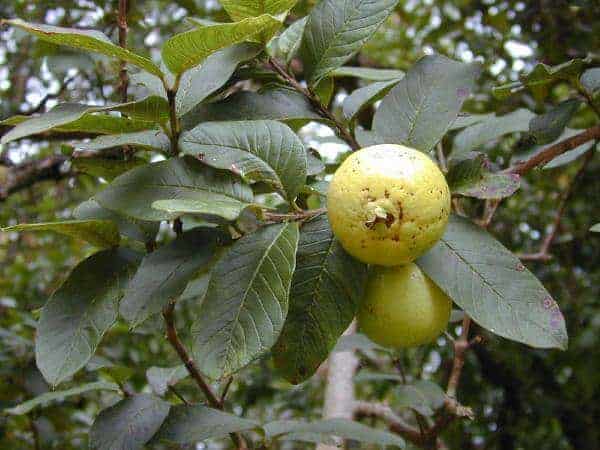No more pitting guava against eucalyptus when it comes to explaining how a poorly understood fungal disease spreads. That is the conclusion reported by an international team of scientists in the journal Molecular Ecology. The team used a common forensic technique to clear guava’s good name.
In reaching its conclusion, the team of Brazilians, Koreans and Americans turned to plant pathologist Tobin Peever of Washington State University. At issue was a fungal pathogen called Puccinia psidii that attacks eucalyptus trees.
Eucalyptus is an enormously valuable tree grown in its native Australia, Brazil and other South American countries, as well as South Africa. In Brazil alone, there are more than 5 million hectares of eucalyptus plantations. The fast-growing tree is primarily used in papermaking, though its oil and leaves are also economically important.
Since eucalyptus grows far from the wheat and lentil fields of the Palouse, why turn to WSU’s Peever for guidance? Though he typically works on pathogens of crops grown in the Pacific Northwest, his reputation as a leading fungal population geneticist is known worldwide. So when Brazilian scientists wanted to test the hypothesis that the rust pathogen infecting eucalyptus originated on guava, they looked to Peever.
Brazil’s Universidade Federal de Viçosa sent graduate student Rodrigo Graça – along with samples from infected guava and eucalyptus trees – to Peever’s lab to ferret out the genetic secrets of P. psidii.
“The arrangement is what we call a sandwich program,” Peever said. “A student takes classes at one university but conducts his or her research program at another institution in order to have access to unique expertise. Graça then returned to his home base in Brazil to analyze the data he collected and write and defend his dissertation.”
Working closely with Peever and Graça were Amy Ross-Davis and Ned Klopfenstein (an adjunct WSU faculty member). Both are based at the U.S. Forest Service Rocky Mountain Research Station in Moscow, Idaho – just a few miles from WSU’s main campus in Pullman. Both are experts in analyzing the genetic variation of plant pathogens.
The scientists used microsatellite analysis to determine that the rust pathogens infecting guava are genetically different from those infecting eucalyptus. Microsatellites are short, repeating bits of DNA that are telling in a forensic sort of way.
They are used to determine kinship, as in paternity tests, as well as in criminal investigations where trace amounts of genetic material are left at the crime scene. They can also be used to detect differences between closely related populations of organisms.
“What we found were several different types of rust pathogen, each infecting a different host plant,” said Peever. “They are all morphologically similar, but they can behave differently – like different types of flu.”
Just as different types of the flu “bug” infect different animals, so too it appears that the various populations or biotypes of P. psidii infect different members of the myrtle family, a large group of tropical shrubs and trees that includes guava, eucalyptus, allspice, clove, rose apple and more than 5,000 other species.
This paints a very different – and much more complex – picture than that assumed before Peever and his colleagues conducted their study.
“For decades, everyone assumed this rust pathogen jumped from guava to eucalypt and that it was native to South America,” said Klopfenstein. That’s because the P. psidii pathogen has been infecting guava in Brazil since the late 1880s and has since spread to the Caribbean, where it infects allspice and rose apple (a fruit-bearing plant related to guava).
The importance of this rust disease was dramatically elevated in 2007 when it was reported in Hawai’i. Native forests there are largely comprised of species in the myrtle family, such as ’ohi’a, that are susceptible to the disease. In 2010, it was detected in Australia, the myrtle family’s center of diversity. The rust disease was reported in South Africa this year.
“It’s pretty much threatening the entire southern hemisphere,” Klopfenstein said.
The rust not only destroys economically important crops, but infected plants throw a wrench in the works of international trade.
Just as a trace of a fungal pathogen in a shipment of wheat grown in the Pacific Northwest would cause it to be blocked from importation into Asia, infected members of the myrtle family may also be stopped at the border. And in Hawai’i, a biotype of P. psidii rust threatens an already overtaxed environment where native plants are barely holding on among a myriad of invasive species.
“The problem, in terms of trade, is that plant health inspection is based largely on visually detectable characteristics of pathogens, and populations of P. psidii all appear morphologically identical,” said Peever. In other words, a shipment might be allowed into a country where P. psidii is already present, even though the type of P. psidii in the shipment is actually going to cause greater damage to other – and locally important – members of the myrtle family.
So, while guava’s name has been cleared, the hypothesis that all P. psidii are the same has been eliminated. In its place is a scene filled with many perpetrators that, while they all look the same, infect different members of the myrtle family.
That’s tough news for plant inspectors until there’s a fast, cheap genetic test that can allow accurate identifications of the various pathogen biotypes.
Developing such a test – sandwich program or not – could be a great project for a graduate student interested in a career in plant pathology.


